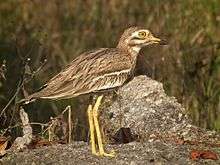Stone-curlew
| Stone-curlews Temporal range: Late Oligocene to present | |
|---|---|
 | |
| Bush stone-curlew, Burhinus grallarius | |
| Scientific classification | |
| Kingdom: | Animalia |
| Phylum: | Chordata |
| Class: | Aves |
| Order: | Charadriiformes |
| Family: | Burhinidae Mathews, 1912 |
| Genera | |
The stone-curlews, also known as dikkops or thick-knees, consist of nine species within the family Burhinidae, and are found throughout the tropical and temperate parts of the world, with two species found in Australia. Despite the group being classified as waders, most species have a preference for arid or semi-arid habitats.
Description
They are medium to large birds with strong black or yellow black bills, large yellow eyes—which give them a reptilian appearance—and cryptic plumage. The names thick-knee and stone-curlew are both in common use, the preference among authorities for one term or the other varying from year to year. The term stone-curlew owes its origin to the broad similarities with true curlews (which are not closely related). Thick-knee refers to the prominent joints in the long yellow or greenish legs and apparently originated with a name coined in 1776 for B. oedicnemus, the Eurasian stone-curlew. Obviously the heel (ankle) and the knee are confused here.[1]
Behaviour
They are largely nocturnal, particularly when singing their loud wailing songs, which are reminiscent of true curlews.[2] The diet consists mainly of insects and other invertebrates. Larger species will also take lizards and even small mammals.[2] Most species are sedentary, but the Eurasian stone-curlew is a summer migrant in the temperate European part of its range, wintering in Africa.
Species
A fossil genus Wilaru, described from the Late Oligocene to the Early Miocene of Australia, was originally classified as a stone-curlew; however, it was subsequently argued to be a member of the extinct anseriform family Presbyornithidae instead.[3] The ten living species are:
| Picture | Name | Binomial name |
|---|---|---|
 |
Eurasian stone-curlew | Burhinus oedicnemus |
 |
Indian stone-curlew | Burhinus indicus |
 |
Senegal thick-knee | Burhinus senegalensis |
 |
Water thick-knee | Burhinus vermiculatus |
.jpg) |
Spotted thick-knee | Burhinus capensis |
 |
Double-striped thick-knee | Burhinus bistriatus |
.jpg) |
Peruvian thick-knee | Burhinus superciliaris |
 |
Bush stone-curlew | Burhinus grallarius (formerly B. magnirostris, the bush thick-knee). |
| |
Great stone-curlew | Esacus recurvirostris |
| |
Beach stone-curlew | Esacus magnirostris |
References
- ↑ Kochan, Jack B. (1994). Feet & Legs. Birds. Mechanicsburg: Stackpole Books. ISBN 0-8117-2515-4.
- 1 2 Harrison, Colin J.O. (1991). Forshaw, Joseph, ed. Encyclopaedia of Animals: Birds. London: Merehurst Press. pp. 105–106. ISBN 1-85391-186-0.
- ↑ Vanesa L. De Pietri, R. Paul Scofield, Nikita Zelenkov, Walter E. Boles and Trevor H. Worthy (2016). "The unexpected survival of an ancient lineage of anseriform birds into the Neogene of Australia: the youngest record of Presbyornithidae". Royal Society Open Science. 3 (2): 150635. doi:10.1098/rsos.150635.
External links
- Thick-knees videos on the Internet Bird Collection